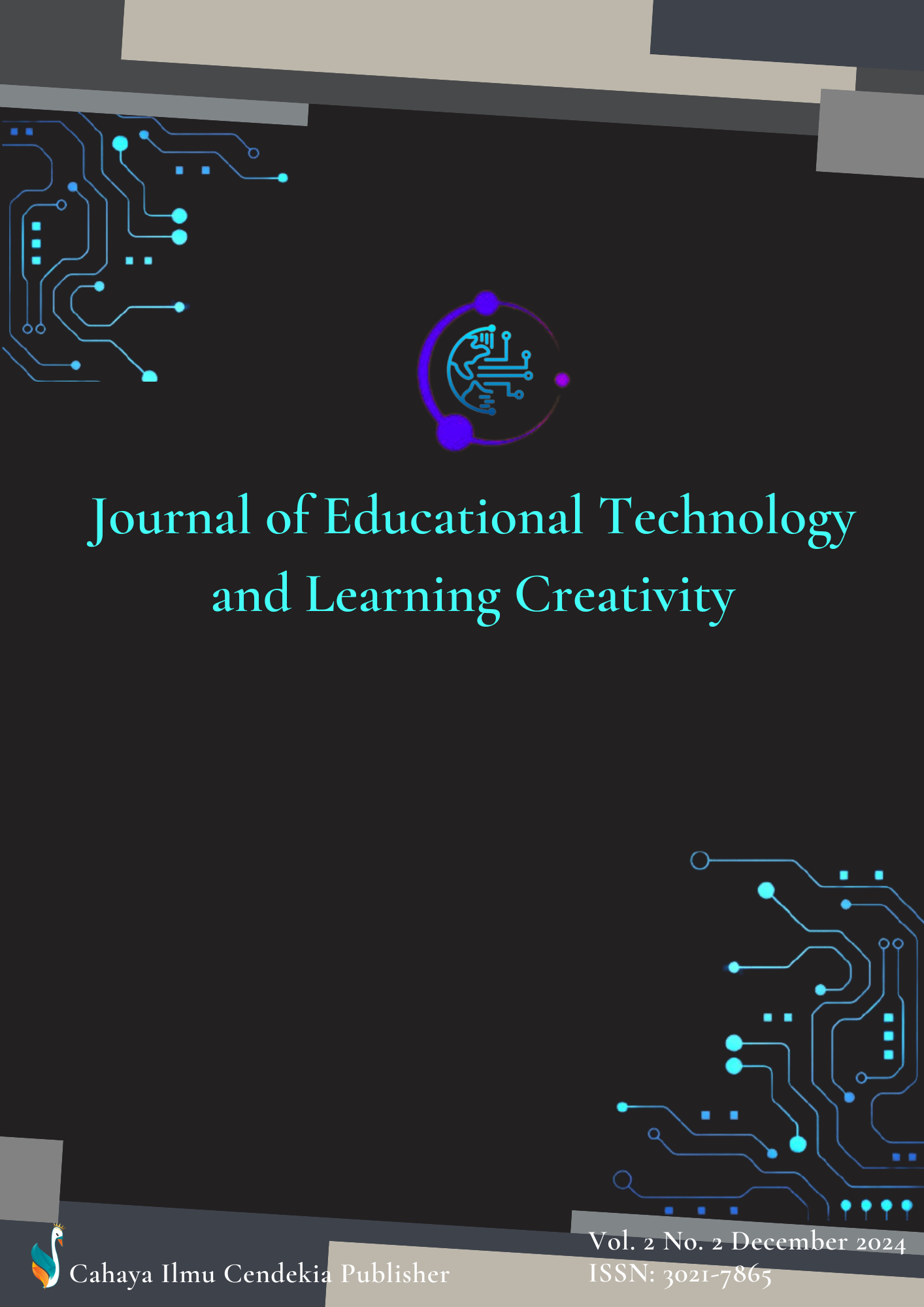Utilization of Information Technology in Increasing the Effectiveness of Citizenship Learning
Abstract
Purpose of the study: This study aims to explore the use of Information and Communication Technology in Citizenship Education learning at State Junior High School 5 Semarang and analyze its impact on student engagement and understanding of the concepts taught.
Methodology: This study uses a qualitative method with data collection techniques through interviews with two teachers and five students. The data obtained were analyzed using a descriptive approach.
Main Findings: The results of the study indicate that the use of information and communication technology in Citizenship Education learning helps improve interaction between teachers and students, makes learning more interesting, and makes it easier for students to understand abstract concepts. However, there are obstacles such as limited devices and unstable internet connections, which can interfere with the learning process. The novelty of this study lies in the holistic approach that not only assesses the effectiveness of information and communication technology in delivering material, but also considers how this technology can increase student active involvement in learning.
Novelty/Originality of this study: These findings provide an important contribution to developing more interactive and technology-based citizenship learning strategies.
References
I. M. Tegeh, A. H. Simamora, and K. Dwipayana, “Pengembangan Media Video Pembelajaran Dengan Model Pengembangan 4D Pada Mata Pelajaran Agama Hindu,” Mimb. Ilmu, vol. 24, no. 2, p. 158, 2019, doi: 10.23887/mi.v24i2.21262.
J. Jusmaniar, I. Riani, E. C. Anderson, M. C. Lee, and S. W. Oktavia, “Gasing Game: Ethnoscientific Exploration of Circular Motion in Physics Learning on the Coast of East Sumatra to Build the Character of Perseverance,” Schrödinger J. Phys. Educ., vol. 5, no. 1, pp. 1–9, 2024, doi: 10.37251/sjpe.v5i1.902.
I Made Marthana Yusa, I. K. Ardhana, I. N. Darma Putra, I. B. G. Pujaastawa, I. G. A. S. Anggara, and N. P. D. Yasa, “Basic 3D Animation Online Learning Model for Multimedia Student,” East Asian J. Multidiscip. Res., vol. 1, no. 11, pp. 2717–2726, 2022, doi: 10.55927/eajmr.v1i11.2297.
G. Daǧhan and B. Akkoyunlu, “Bilişim teknolojileri dersinde kullani{dotless}lan performansa dayali{dotless} deǧerlendirme yöntemlerine İlişkin nitel bir çali{dotless}şma,” Kuram ve Uygulamada Egit. Bilim., vol. 14, no. 1, pp. 333–338, 2014, doi: 10.12738/estp.2014.1.2005.
R. Sudrajat, “Pemanfaatan Media ICT Pembelajaran Pendidikan Pancasila dan Kewarganegaraan Untuk Meningkatkan Kompetensi Kewarganegaraan di SMA 2 Mranggen,” Civis, vol. IX, no. 1, pp. 40–60, 2020, [Online]. Available: http://journal.upgris.ac.id/index.php/civis/article/viewFile/6082/3169
C. Febriyanti, R. Prasetya, and A. Irawan, “Etnomatematika Pada Permainan Tradisional Engklek Dan Gasing Khas Kebudayaan Sunda,” Barekeng J. Ilmu Mat. Dan Terap., vol. 12, no. 1, p. 1, 2018, doi: 10.30598/vol12iss1pp1-6ar358.
A. Wulandari, P. Handayani, and D. R. Prasetyo, “Pembelajaran Ilmu Pengetahuan Alam Berbasis EMC (Education Mini Club) sebagai Solusi Menghadapi Tantangan Pendidikan dI Era Revolusi Industri 4.0,” Thabiea J. Nat. Sci. Teach., vol. 2, no. 1, p. 51, 2019, doi: 10.21043/thabiea.v2i1.5498.
R. Perdana, S. W. Oktavia, and F. P. Sinaga, “Effective Learning Strategies : Minimum Completeness Criteria and Remedial Program as an Effort to Improve Physics Learning on Dynamic Fluid Material,” vol. 5, no. 3, pp. 123–127, 2024, doi: 10.37251/jee.v5i3.815.
R. Jaya, L. Djafaar, and C. Cuga, “Pendidikan Kewarganegaraan Sebagai Wahana Pengembangan Wawasan Kebinekaan Global Siswa,” J. Soc. Sci. Res., vol. 3, no. 2, pp. 10643–10655, 2023, [Online]. Available: https://j-innovative.org/index.php/Innovative/article/view/1647/1216
S. W. Oktavia, N. N. Qoidah, I. Giorgadze, and C. Gasparin, “Exploring Local Wisdom: Improving Basic Skills in Heat Transfer material through Developing a Physics Module Based on Smoked Fish,” Schrödinger J. Phys. Educ., vol. 4, no. 4, pp. 125–131, 2023, doi: 10.37251/sjpe.v4i4.921.
I. Magdalena, A. S. Haq, and F. Ramdhan, “Pembelajaran Pendidikan Kewarganegaraan Di Sekolah Dasar Negri Bojong 3 Pinang,” J. Pendidik. dan Sains STITPN, vol. 2, pp. 97–104, 2020, [Online]. Available: https://ejournal.stitpn.ac.id/index.php/bintang/article/download/995/689
E. Y. R. Pratiwi and M. B. E. Siswanto, “Pengembangan Education Game Berbasis Microsoft Power Point dalam Media Pembelajaran Pendidikan Kewarganegaraan,” DWIJA CENDEKIA J. Ris. Pedagog., vol. 4, no. 1, p. 162, 2020, doi: 10.20961/jdc.v4i1.43331.
N. Hekmah, I. Wilujeng, and I. G. P. Suryadarma, “Web-Lembar Kerja Siswa IPA terintegrasi lingkungan untuk meningkatkan literasi lingkungan siswa,” J. Inov. Pendidik. IPA, vol. 5, no. 2, pp. 129–138, 2019, doi: 10.21831/jipi.v5i2.25402.
A. Hassi and G. Storti, “Globalization and Culture: The Three H Scenarios,” Glob. - Approaches to Divers., pp. 3–20, 2012, doi: 10.5772/45655.
E. M. Manurung, Y. S. Purwadi, and I. B. Sugiharto, “Digital Learning Process: Challenges for Specific Creativity,” Electron. J. e-Learning, vol. 20, no. 2, pp. 112–119, 2022, doi: 10.34190/ejel.20.2.2107.
Astalini, Darmaji, D. A. Kurniawan, S. W. Oktavia, E. Triani, and M. Z. Azzahra, “The Exploration of Character Values in Physics Learning on Momentum, Impulse, and Collision Materials,” J. Educ. Res. Eval., vol. 7, no. 2, pp. 277–284, Jun. 2023, doi: 10.23887/jere.v7i2.52381.
L. Anggraini, F. P. Sinaga, and S. W. Oktavia, “Identification of Discovery Learning Method Based on Edutainment ( Zenius ) to Increase Student Motivation on Business and Energy Materials,” vol. 5, no. 3, pp. 138–143, 2024, doi: 10.37251/jee.v5i3.812.
N. Azizah, H. Muluk, and M. N. Milla, “Pursuing ideological passion in Islamic radical group’s insurgency: a case study of Negara Islam Indonesia,” Indones. J. Islam Muslim Soc., vol. 13, no. 1, pp. 1–27, 2023, doi: 10.18326/ijims.v13i1.1-27.
J. W. Creswell, Research Design Pendekatan Kualitatif, Kuantitatif, dan Mixed. Yogyakarta: Pustaka Belajar, 2013.
M. Abduh, T. Alawiya, G. Apriansyah, R. A. Sirodj, and M. W. Afgani5), “Survey Design: Cross Sectional dalam Penelitian Kualitatif,” J. Pendidik. Sains dan Komput., vol. 3, no. 1, pp. 31–39, 2023, doi: 10.22437/jiituj.v5i1.12886.
N. Lolita, F. Fitriani, L. Cantika, and S. Afrianda, “Analisis Hasil Belajar Fisika Siswa pada Materi Fluida Statis,” Schrödinger J. Phys. Educ., vol. 1, no. 4, pp. 112–116, 2020, doi: 10.37251/sjpe.v1i4.446.
D. A. Rosyida and Z. Della Saputri, “Cultivating character education for prospective elementary school teachers through elementary social studies courses,” ROMEO Rev. Multidiscip. Educ. Cult. Pedagog., vol. 1, no. 3, pp. 103–112, Jun. 2022, doi: 10.55047/romeo.v1i3.339.
Muhammad Musyaddad, Feliza Paramitha Sinaga, and Sri Wina Oktavia, “Analisis Keterampilan Kolaborasi Peserta Didik Pada Mata Pelajaran Fisika Di Sman Titian Teras Kabupaten Muaro Jambi,” Sci. Educ. J., vol. 1, no. 2, pp. 48–65, 2024, doi: 10.62872/gx3nqe02.
Nurhikmah and E. Hasanah, “Manajemen Pembelajaran Berbasis Lingkungan di Sekolah Dasar 07 Pekat NTB,” J. Stud. Guru dan Pembelajaran, vol. 4, no. 2, pp. 272–281, 2021, doi: 10.30605/jsgp.4.2.2021.570.
S. C. Eze, V. C. A. Chinedu-Eze, C. K. Okike, and A. O. Bello, “Factors influencing the use of e-learning facilities by students in a private Higher Education Institution (HEI) in a developing economy,” Humanit. Soc. Sci. Commun., vol. 7, no. 1, pp. 1–15, 2020, doi: 10.1057/s41599-020-00624-6.
V. Y. Nurdanti, “Pengaruh Minat Belajar terhadap Hasil Belajar Fisika Peserta Didik,” Schrödinger J. Phys. Educ., vol. 1, no. 4, pp. 101–106, 2020, doi: 10.37251/sjpe.v1i4.444.
M. Astatke, C. Weng, and S. Chen, “A literature review of the effects of social networking sites on secondary school students’ academic achievement,” Interact. Learn. Environ., vol. 31, no. 4, pp. 2153–2169, 2023, doi: 10.1080/10494820.2021.1875002.
K. Pinontoan, M. Walean, and A. Lengkong, “Pembelajaran Daring Menggunakan E-Modul pada Flipped Classroom Statistika untuk Meningkatkan Kemampuan Bernalar dan Intensi Berwirausaha,” JINOTEP (Jurnal Inov. dan Teknol. Pembelajaran) Kaji. dan Ris. Dalam Teknol. Pembelajaran, vol. 8, no. 1, pp. 1–10, 2021, doi: 10.17977/um031v8i12021p001.
Á. Dias, G. M. Silva, M. Patuleia, and M. R. González-Rodríguez, “Transforming local knowledge into lifestyle entrepreneur’s innovativeness: exploring the linear and quadratic relationships,” Curr. Issues Tour., vol. 24, no. 22, pp. 3222–3238, 2021, doi: 10.1080/13683500.2020.1865288.
S. Schallert, Z. Lavicza, and E. Vandervieren, “Merging flipped classroom approaches with the 5E inquiry model: a design heuristic,” Int. J. Math. Educ. Sci. Technol., vol. 53, no. 6, pp. 1528–1545, 2022, doi: 10.1080/0020739X.2020.1831092.
M. Mullen, “Promoting informal learning by integrating smartphones into the language classroom,” CALL Prof. short Pap. from EUROCALL 2021, vol. 2021, no. 2021, pp. 232–237, 2021, doi: 10.14705/rpnet.2021.54.1338.
Ł. Tomczyk, “Skills in the area of digital safety as a key component of digital literacy among teachers,” Educ. Inf. Technol., vol. 25, no. 1, pp. 471–486, 2020, doi: 10.1007/s10639-019-09980-6.
E. Ardila and S. Hidayah, “Realization of Learning Islamic Education Through Multimedia at Madrasah Aliyah Negeri 3 Indragiri Hilir,” J. Pendidik. Agama Islam Indones., vol. 4, no. 2, pp. 27–32, 2023, doi: 10.37251/jpaii.v4i2.658.
Copyright (c) 2024 Teguh Basuki Rachmanto, Itunu Olaniran Akande

This work is licensed under a Creative Commons Attribution 4.0 International License.
Authors who publish with this journal agree to the following terms:
- Authors retain copyright and acknowledge that the Journal of Educational Technology and Learning Creativity is the first publisher licensed under a Creative Commons Attribution 4.0 International License.
- Authors are able to enter into separate, additional contractual arrangements for the non-exclusive distribution of the journal's published version of the work (e.g., post it to an institutional repository or publish it in a book), with an acknowledgment of its initial publication in this journal.
- Authors are permitted and encouraged to post their work online (e.g., in institutional repositories or on their website) prior to and during the submission process, as it can lead to productive exchanges and earlier and greater citation of published work.


.png)


.png)
.png)
.png)












